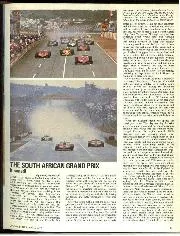
1979 South African Grand Prix race report
It rained! Kyalami, March 3rd Confusion rained at Kyalami long before the Grand Prix of South Africa was due to start. While everyone was heading for the southern hemisphere to…

People often ask me what my favourite race is, or which is the best race to go to as a fan, and it’s always hard to pick just one. There are so many good races on the calendar it really depends what you want from your F1 experience. If it’s fan passion you want then it’s Silverstone or Monza; if it’s a great vibe downtown then you can’t go wrong with Austin, but if you want to really experience glitz and glamour then it’s either Monaco or Singapore – and if you add in the favourable cost and the sizzling temperatures, then Asia is a must.
As the BBC’s F1 presenter, it’s my job to paint the picture of a race weekend and for those who may never get to experience a race live, to take them as close to the action as I can, and I have to say the place I enjoy doing this most is the Singapore Grand Prix.
My first trip to Singapore didn’t go brilliantly. I remember being on the aircraft, flying in and not feeling great. The next thing I knew I was on the floor at the back of the aircraft with my legs up on a cabin box and an oxygen mask over my face. It was 2012 and I was fairly new to the media pack – despite that, half the paddock seemed to be crammed into the back of the plane having a good look at the ‘one who had passed out’. The humiliation didn’t end there as I was ushered past the waiting masses at immigration and taken to the front of the queue in a wheel chair – my producer at this moment looked rather pleased – me, not so much. It wasn’t exactly the best way to start my weekend.
As you drive into the city one of the first things you see is the Singapore Flyer – their version of the London Eye – and as you cross the bridge into the downtown area you drive straight over the top of the start/finish straight and the pit and paddock complex. It’s a really cool way to start proceedings and gives you a good idea of what’s ahead.
“You can get much closer to the action than usual at the Singapore Grand Prix”
One of the strangest things about the Singapore race is that the paddock stays on European time, which can make life both surreal and a little difficult at times. You’re going to bed at about 3 or 4am and trying not to wake up until early afternoon.
Most of the teams stay in hotels that understand the complexities of this challenge. We stayed in the same hotel as the Williams and Force India teams for several years and they organise breakfast to be served at lunchtime. In fact, there are hotels who block book whole floors for the F1 community so they can sleep in peace even though the rest of the hotel is running normally.
Singapore has some amazing restaurants but, like most countries, they close at around 10pm. This means that when majority of the paddock finishes work they decamp to one of several hawker stalls – informal groups of stands that serve the likes of spicy Singapore crab or flame-grilled satay sticks. Newton Circus is the most popular of these. Turn up on any night of a grand prix weekend and you will find a whole array of TV presenters, F1 media and team personnel who are lucky enough not to have to be working all night.
There’s a wonderful old Singaporean lady who has worked there for years. She rushes around serving beer and shouting at people. It’s a great experience and they stay open until the sun starts to whisper that it may be about to rise. It’s a fantastic place to while away the hours until you can acceptably go to bed.
The weather is always hot and humid. The walk to the track, either on the roads that are still open or through the bustling streets and then into the air-conditioned shopping malls, is something unique to Singapore. At no other venue do you see mechanics walking in full team kit. The only people usually seen around town in team colours are fans wearing merchandise. If you just happen to be in the right place at the right time, and you’re loitering near the track, it’s not so rare to see the drivers making their way in on foot, too. It’s a good track for selfies and autograph hunters.
The stars who come to the grand prix are always impressive too, whether they’re playing gigs in the fan zone or just parading on the grid. One of my favourite interviews for the BBC in those 30 minutes before the race starts was when I stuck a microphone between Bernie Ecclestone and David Beckham and had a chat with them about football and F1. Beckham was like an excitable schoolboy, looking at all the cars and fanboying the drivers.
But you don’t have to be a celebrity or spend thousands of pounds to drink champagne and eat lobster in the Paddock Club to have fun. A normal ticket can bring you really close to the action and you can amble your way around the track getting far closer to the action and the teams than any other race on the calendar.
In this respect, I can’t help feeling that despite being a relatively new addition to the F1 calendar (it arrived in 2008 – also the race in which Nelson Piquet Jr controversially crashed in an accident that was later found to have been deliberate), Singapore is closer in spirit to how grand prix racing used to be. I just hope I don’t pass out on the plane again…
Jennie Gow has formed a staple of the BBC’s Formula 1 broadcasting team since 2011, working across both TV and radio
Follow Jennie on Twitter @JennieGow